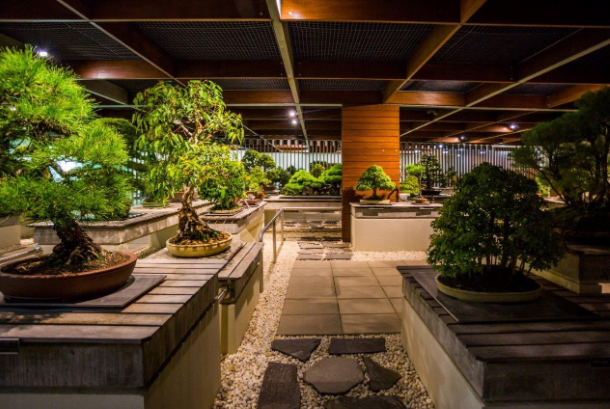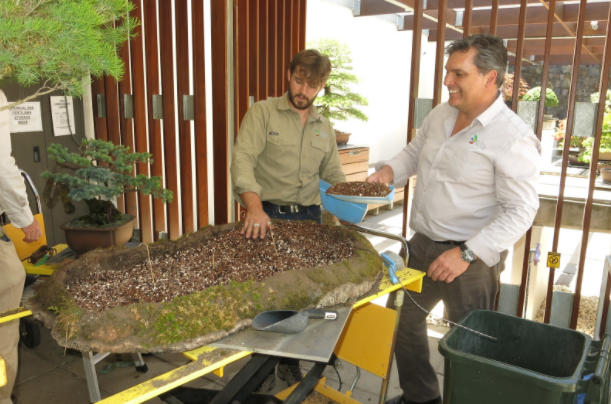Kaneshiro works on a juniper group planting on a volcanic slab in Seattle, July 1984. Photo: ABS Bonsai Journal
When Jane Nakama reflects on the momentous legacy her father Haruo “Papa” Kaneshiro left behind, she most fondly remembers the people she met during his impressive life as a bonsai master.
Whether she traveled alongside her father to another part of the world or helped her parents entertain fellow bonsai lovers, including those who started as strangers, Nakama met wonderful artists from Europe, Australia and Asia and beyond.
“The bonsai community is filled with just above-and-beyond good people, and I totally appreciate that connection with people even today, 25, 30 years after dad’s passing,” she said. “It’s mind boggling to think all that connecting happened by word of mouth. It’s just amazing what bonsai brought to their lives.”
Christened “Papa” by the bonsai community for his father-like persona, Kaneshiro is touted for his unselfish and inclusive teaching and lifestyle. Kaneshiro was one of the founding members of the North American Bonsai Federation, a branch of the World Bonsai Friendship Federation.
But Nakama said her father didn’t truly develop his bonsai artistry until his mid-40s. In fact, Kaneshiro spent much of his early life working in restaurants and retired in his early 50s.
He met his wife, Masako, while working for her older brother who ran a fine dining and dancing restaurant. Nakama said her father had been waiting tables at elegant hotels in Hawaii, but he decided to open his own restaurant where his wife ran the front and waited tables as he baked pies and made soups from scratch with a wood-burning stove.
“He’d purchase these logs, place them in the back of the restaurant and his friends would come over and chop them to fit the oven,” she said.
Nakama said Kaneshiro’s interest in bonsai first sprouted when he was younger and traveled every so often to visit a friend who had bonsai in their backyard. But he really explored his passion for the art after he retired from being a restaurant owner and started subbing as a manager at an upscale restaurant when the current manager would go on vacation.
The six Kaneshiro siblings and their mother Masako at dinner to celebrate the dedication of the National Bonsai & Penjing Museum’s Haruo Kaneshiro Tropical Conservatory in 1993. Photo from Jane Nakama.
Kaneshiro’s Teaching Style
Nakama noted that there was an absence of organized classes or demonstrations when Kaneshiro was learning and first teaching the art of bonsai, so he had to order textbooks from Japan.
“He was really self taught through experience,” she said.
But her father’s influence as a master did not hinge on rigid teaching plans of bonsai rituals and traditions as an exact science with strict styling rules. Papa Kaneshiro believed that, just as every person is different, every plant is different; therefore bonsai should be each person’s own expression of how they think a tree should look in nature.
“He shared a lot of this philosophy, too, so I think that’s why bonsai flourished in Hawaii,” Nakama said. “He tried to emulate nature in its most natural forms. He always said, ‘The plant will tell you how it wants to grow – you just guide it.’”
After Kaneshiro passed, his widow Masako donated many plants to the National Bonsai Foundation, and an auction on the family’s property raised more than $10,000 to fund the creation of the Haruo Kaneshiro Tropical Conservancy at the National Bonsai & Penjing Museum.
“I’m very grateful that Mom and Dad were into bonsai as much as they were,” she said. “It was more than a shared hobby – the people we met were just incredible and changed their lives forever.”
One of Papa’s trees at our Museum: a Chinese Banyan. Read more about the bonsai in our Historical Tree Spotlight.
Working Under Papa Kaneshiro
David Fukumoto, the owner of Fuku-Bonsai Cultural Center in Hawaii, said he was lucky to have Papa Kaneshiro as both a friend and a mentor who defended his amateur bonsai efforts.
Fukumoto said Kaneshiro understood the differences between the horticultural and ethnic cultural principles that dominate "traditional Japanese bonsai" as well as the greater Hawaiian multi-cultural values and tropical trees.
“He was a gentle non-conformist who politely praised everyone's bonsai efforts and did not try to impose his values on anyone,” Fukumoto said. “Because of him, Hawaii bonsai is family oriented and the friendships are probably more significant.”
Many bonsai teachers who came to Hawaii taught training techniques like cutting off aerial roots, creating single trunk and training flat branch tiers to adhere to bonsai “rules” codified in the 1950s. Papa Kaneshiro trained his black pines in this manner, but he trained his other bonsai with “natural style,” Fukumoto said.
When Japanese bonsai artists were given opportunities to teach bonsai in Hawaii, they tended to train ficus banyan bonsai by cutting off aerial roots, creating only a single trunk, and training flatten tiers of branches.
“He encouraged each of us to follow natural tree structure, to be creative and create beautiful potted plants,” Fukumoto said. “Although bonsai was a large part of their lives, the Kaneshiro’s generous and thoughtful hospitality was legendary.”
The Kaneshiro family and bonsai community after the auction of Papa’s trees, the proceeds of which went to the U.S. National Arboretum. Photo from Jane Nakama.
































